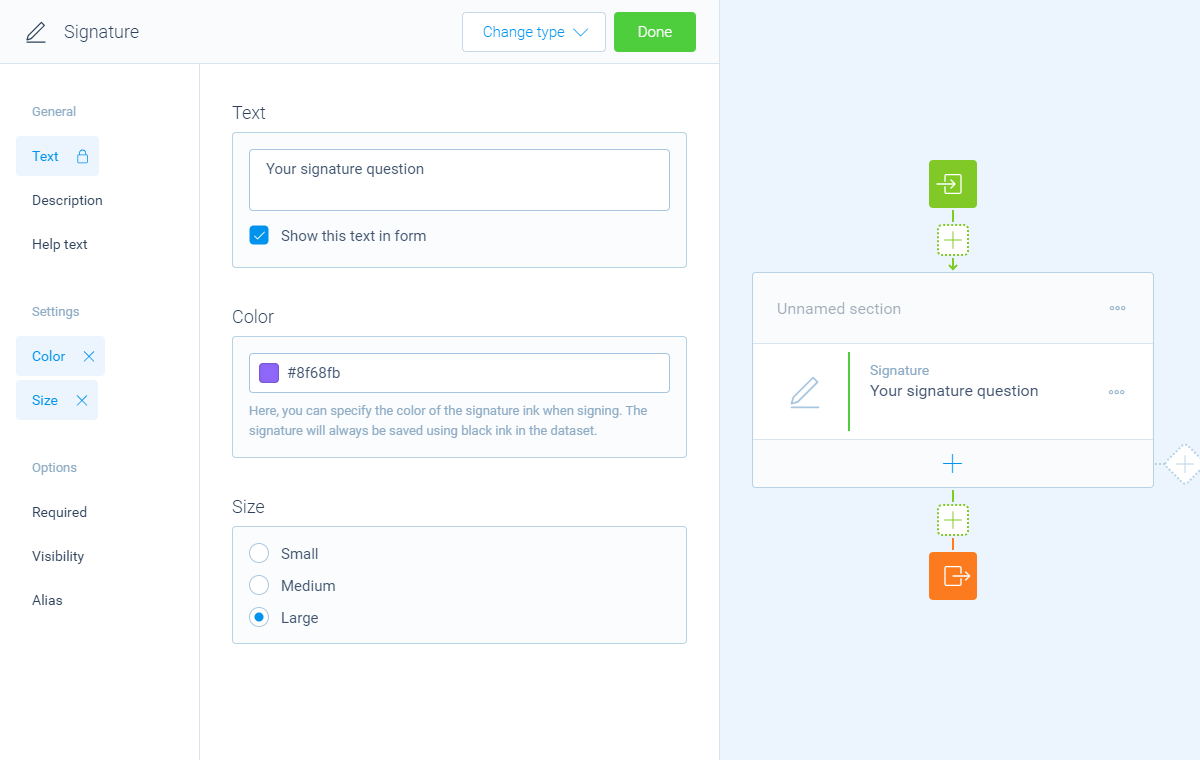How to use the signature block
Learn everything you need to know to use the signature block in your forms.
When to use
Use the signature block to let your respondents draw a signature within your form. The respondent can draw a signature with mouse, pen or touch. When the signature is completed it will be confirmed and stored as an image in your results.

How to use
Add a new block to your form and then select the question type Signature. You can now customize this block to your needs with the following features:
General
- Text
Use theTextfeature for the name/title of this block. - Description
Enable theDescriptionfeature to add a description to this block. - Help text
Enable theHelp textfeature to add a help text to this block.
Settings
- Color
By default the signature is drawn in the main color of your styling. Enable theColorfeature to overrule that color with a custom color for the signature ink. The signature will always be stored using black ink. - Size
By default the signature drawing field is shown as medium sized. Enable theSizefeature to choose what size the drawing field should have:Small,MediumorLarge.
Options
- Required
By default this block is not required to fill out by your respondents. Enable theRequiredfeature to make this block required to fill out. - Visibility
By default this block is visible in your form. Enable theVisibilityfeature to hide it for your respondents. - Alias
By default the name/title of this block will be used in your dataset. Enable theAliasfeature to use a different name in your dataset.

Storage
Each signature is stored in your dataset as an image with filename signature-YYYYMMDDHHMMSS.png. You can easily preview a signature in the results, or download a copy of the image.
Logic
Logic is important to make your forms smart and conversational. The signature block can work with the following branch conditions to help you with that:
Block conditions
- Signed;
- Not signed.
Evaluate conditions
Evaluate conditions are done with the signature file name, which is a fixed file name in this format: signature-YYYYMMDDHHMMSS.png.
- Value matches
your filter; - Value does not match
your filter; - Value contains
your filter; - Value does not contain
your filter; - Value starts with
your filter; - Value ends with
your filter; - Value is empty;
- Value is not empty.
Filters
When we mention your filter above, there are some different filters that you can use to make the right comparison:
- Text - Compare with a fixed text that you enter;
- Value - Compare with another block value entered in the form by a respondent (more info).
Calculations
You can use the calculator block to perform calculations with given answers. For the signature block these calculations are done using the signature file name, which is a fixed file name in this format: signature-YYYYMMDDHHMMSS.png. The signature block supports the following calculation operations:
- Compare - Compare a file name and output a value based on the result of the comparison;
- Character count - Count the number of characters in a file name;
- Word count - Count the number of words in a file name;
- Line count - Count the number of lines in a file name;
- Count occurrences - Count the number of occurrences of a certain text, character or regular expression in a file name;
- Convert to number - Convert a file name to a number value.
